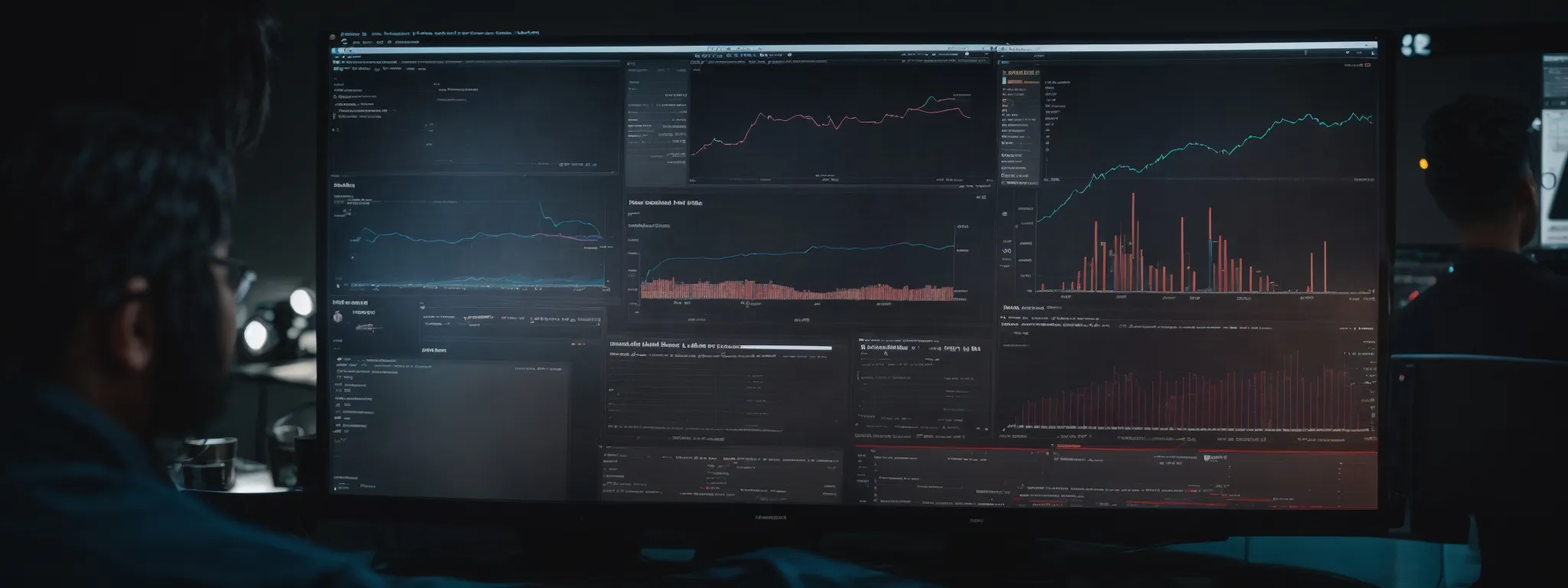Google Click Depth Matters Seo Url Structure
Understanding How Google Click Depth Influences SEO URL Structure Mastery of search engine optimization requires a keen understanding of various factors that contribute to high search engine […]
Understanding How Google Click Depth Influences SEO URL Structure
Mastery of search engine optimization requires a keen understanding of various factors that contribute to high search engine rankings, among which are the often-overlooked elements of click depth and URL structure.
The distance that a page stands from the home page, known as click depth, holds significant sway over a site’s ability to engage users and appeal to search engine crawlers.
Equally, the clarity of a website’s URL structure is a subtle yet powerful lever in the machine of digital marketing, offering cues to both search engines and visitors regarding site hierarchy and content relevance.
An optimized approach to these components can create a synergy that propels a website to the top of search results.
Keep reading to demystify the complex interplay between click depth and URL structuring, and how it can be harnessed for effective SEO outcomes.
Key Takeaways
- Click Depth Significantly Affects a Site’s Search Engine Ranking and User Experience
- LinkGraph’s SEO Services Optimize Website Navigation and URL Structures for Enhanced Visibility and Easier Indexing by Search Engines
- Strategic Internal Linking Can Improve Both User Navigation and Equitable Link Equity Distribution Throughout a Site
- Proactive Adaptation to SEO Trends, Including URL Reconfiguration for Optimal Click Depth, Is Necessary to Maintain Search Relevancy
- Empirical Data and Analytics Play a Crucial Role in Refining SEO Strategies and Ensuring Effective Click Depth on Websites
Exploring the Basics of Click Depth in SEO

In the intricate tapestry of Search Engine Optimization (SEO), every detail can significantly sway a site’s visibility and search ranking.
Click depth, a factor often overshadowed by its more popular counterparts, emerges as an essential element in structuring a website that pleases not only the discerning eyes of Googlebot but also the convenience-driven preferences of users.
This concept delves into how many clicks are needed to navigate from the home page to a given page.
Understanding click depth is crucial in revealing how search engines, like a seasoned cartographer plotting a map, assess the accessibility of a site’s inner sections.
Furthermore, it sheds light on the often-overlooked influence click depth can wield over site indexing, which, when optimized, can streamline a path for search engine crawlers, leading to more prominent placement in search results and potentially enhancing the overall user experience.
Defining Click Depth and Its Role in SEO
Click depth pertains to the number of hyperlinks a user must traverse to reach a particular page beginning from the home page. This metric directly correlates with the ease of site navigation and, by extension, the user experience. Search engines utilize this structure to prioritize web pages, with shallower click depths often favored for their accessibility.
In the domain of SEO, thorough attention to click depth contributes to a more intelligible and user-friendly site architecture. It plays a decisive role in enhancing the authority and visibility of a page within search engine rankings, emphasizing the notion that a streamlined path between the root domain and individual pages can be consequential for digital success.
How Search Engines Interpret Click Depth
Search engines, with Google at the forefront, gauge click depth as a reflection of a webpage’s accessibility, where a fewer number of clicks signifies a stronger likelihood of page visits and consequently, increased importance attributed by the search algorithms. They dissect the website structure, rewarding those where vital information and pages are readily discoverable with minimal navigation effort.
By analyzing URL structure, search engines like Google can discern the hierarchical arrangement of content, with the click depth providing insight into how the site architecture serves the searcher’s intent. This influences not only the crawl depth for Googlebot but also positions site content to potentially earn higher placement in search engine results pages (SERPs).
The Impact of Click Depth on Site Indexing
The intricacies of site indexing cannot be understated, with click depth playing a substantial role in shaping a search engine’s perception and access to content. A streamlined click path ensures that search engine spiders, such as Googlebot, can efficiently access and index web pages, bolstering a site’s visibility in the digital realm.
LinkGraph’s Adept SEO Services put an emphasis on optimizing URL structure, ensuring that essential pages are not buried deep within a website’s hierarchy. By creating an XML sitemap and devising a strategic site architecture, LinkGraph guarantees that site indexing is precise and comprehensive, allowing for superior search engine optimization and performance in SERPs.
The Significance of URL Structure for Click Depth

As one navigates the complex roadways of SEO, the construction of URL hierarchy emerges as an influential driver in click depth optimization.
This hierarchy defines how web pages are logically organized and accessed, shaping the path a user or crawler takes through a website.
Immaculate URL structuring practices not only enhance a site’s navigability but also inform search engines of the relative importance and relation between pages, thus impacting overall SEO performance.
In the pursuit of mastering SEO URL structure, it is imperative for site owners to grasp the elements of URL hierarchy, institute effective structuring techniques, and sidestep the pitfalls that can obfuscate a site’s click depth strategy.
Understanding URL Hierarchy and Its Influence on Click Depth
An expertly designed URL hierarchy acts as a roadmap for both users and search engine crawlers, setting a clear foundation for website navigation: By establishing a logical structure within the URL, site owners enable a more intuitive discovery process, thereby enhancing click depth and, subsequently, SEO efficacy.
- Create intuitive top-level domains that clearly indicate the site’s primary focus.
- Use subdirectories to logically categorize content, aiding users and crawlers alike.
- Implement keyword-rich but concise URLs to improve relevance and search engine visibility.
The influence of URL hierarchy on click depth extends to shaping the user’s journey through a website, guiding them with precision to the desired content. A well-thought-out URL structure leads to improved user satisfaction and retention, which are critical factors in boosting a site’s search engine rankings and overall online success.
Best Practices for Structuring URLs Effectively
Adopting a consistent approach when structuring URLs can substantially enhance their effectiveness in contributing to a favorable click depth. Strategic utilization of relevant keywords within URLs fortifies their discoverability and relevance, paving the pathway for an enriched user experience and a bolstered SEO profile.
For site owners intent on optimizing their digital assets, a few key tactics stand out:
- Minimize URL length to ensure clarity and ease of sharing while maintaining keyword pertinence.
- Maintain a logical flow with a breadcrumb-like format that intimates the content hierarchy and relationship between pages.
- Avoid excessive use of parameters and dynamic URLs that can complicate a crawler’s ability to index a site efficiently.
Furthermore, LinkGraph’s SearhAtlas SEO Tool innovatively underpins these URL structuring principles, directly aligning click depth considerations with overarching SEO strategy. This integration amplifies navigational simplicity and search engine interpretability, ultimately nurturing heightened prominence within digital landscapes.
Common URL Structuring Mistakes to Avoid
Navigating the complexities of SEO, site owners should eschew neglecting URL consistency. One prevalent misstep includes using inconsistent, case-sensitive URLs that fracture click depth efficiency and cause duplicate content issues, hindering a brand’s digital marketing footprint and muddying the clarity of site structure for Google’s discerning algorithms.
Another oversight involves overlooking URL redirects after site restructuring or content updates, which can create dead ends for users and search engine crawlers alike. This lapse in technical SEO can sever link equity and obscure the click path that underpins smooth user journeys and seamless site indexing, thus compromising search engine visibility and SEO results.
Practical Strategies to Optimize Click Depth

For the astute webmaster, recognizing click depth’s pivotal role is paramount in crafting an effortlessly navigable website that resonates with both search engine crawlers and users alike.
With the endeavor of refining SEO URL structure, professionals must adopt key strategies to diminish click depth, ensuring a streamlined experience from the root domain to each unique page.
The following tactics—simplifying website navigation, instituting a flat site architecture for enhanced content discoverability, and deploying internal linking smartly—embody practical solutions to improve click depth metrics, which in turn can fortify a site’s search engine standings and elevate user engagement levels.
Simplifying Website Navigation to Reduce Click Depth
LinkGraph’s SEO Services Pivot around tailoring site navigation to be as straightforward as possible, significantly reducing the distance—measured in clicks—that a visitor must journey to access important content. Streamlining the navigational structure creates a more coherent flow and avoids unnecessary complexity, directly influencing Google’s evaluation of a website’s user-friendliness and content accessibility.
By refining website navigation, a site owner directly addresses one of the pivotal Google ranking factors, enhancing the brand’s prominence in the digital ecosystem. The meticulous crafting of a click-optimized navigation bar and clear, logical linking between pages is a testament to the company’s commitment to facilitating a superior user experience and solidifying a powerful SEO foundation for clients.
Enhancing Content Discoverability With a Flat Site Architecture
LinkGraph’s SEO Strategy Incorporates the principle of a flat site architecture to propel content visibility. This design approach places crucial pages just a few clicks away from the home page, considerably enhancing the ease with which both users and search engine crawlers can discover valuable content.
Adeptly structuring a digital storefront demands attention to site architecture for improved user navigation and crawler efficiency: LinkGraph simplifies this process by advocating for fewer hierarchical levels and promoting a more straightforward layout that caters to a seamless browsing experience.
| SEO Aspect | Traditional Deep Architecture | LinkGraph’s Flat Architecture Approach |
|---|---|---|
| Click Depth | Higher number of clicks required | Minimized to enhance UX and crawlability |
| Content Accessibility | Content buried and hard to find | Content is visible and easy to access |
| Indexing by Search Engines | More complicated and slow | Efficient and comprehensive |
Utilizing Internal Linking to Improve Click Depth Metrics
LinkGraph Harnesses the Power of Internal Linking to refine click depth metrics, ensuring that each hyperlink serves as a connective thread that guides users with purpose and precision throughout a website. Strategic internal links enable a robust site architecture that is user-centric, allowing product pages, blog posts, and other content to be accessed swiftly and increasing the likelihood of stronger search engine rankings.
By crafting a network of relevant, contextually connected internal links, LinkGraph aids in distributing pagerank across the website, bridging the click path between the home page and deeper sections of the site with ease. This approach not only benefits the user experience by providing relevant additional content but also signals to search engine crawlers the importance of various pages based on their proximity and interconnectivity to the root domain and pillar content:
- Promoting a comprehensive internal linking strategy for seamless navigation.
- The importance of including linkable assets within a site’s key sections.
- Identifying opportunities for cluster content that resonates with the searcher’s intent.
Click Depth vs. Link Equity Distribution

The dynamic interplay between click depth and link equity distribution stands as a core consideration for any astute site architect seeking to maximize SEO through meticulous URL structuring.
As page depth within a site’s hierarchy informs the dispersal of PageRank, the lifeblood of a page’s authority, the careful calibration of click distance against the equitable spread of link value is paramount.
Methods that ensure a balanced distribution of link equity can significantly influence a site’s Google ranking, directing the flow of page authority effectively throughout a website’s ecosystem, ultimately reinforcing each page’s potential to surface prominently in search engine results.
Balancing Click Depth and Link Value Across Web Pages
In the realm of SEO, effective management of click depth serves not just to simplify navigation but also to strategically disperse link equity. A judicious balance is struck as LinkGraph meticulously calibrates the number of hyperlinks leading to a page, ensuring each carries adequate link value to bolster the page’s prominence within the search engine ecosystem.
LinkGraph champions the art of distributing link equity so that each webpage garners sufficient authority without compromising the user’s ability to reach the content deftly. The sophistication in structuring URLs to support this equilibrium enables a harmonious blend of user-centered design and search engine optimization, setting a robust foundation for improved search rankings.
How Click Depth Affects PageRank Flow Within a Website
PageRank flow, a paramount Google ranking factor, is intricately entwined with click depth, as it quantifies the transfer of page authority through hyperlinks. Deeper click depths can stymie the flow of PageRank, potentially diminishing a webpage’s capacity to outrank competitors in SERPs, as distant pages receive less authority from the root domain.
LinkGraph harnesses this understanding to structure URLs effectively, ensuring vital pages maintain shallow click depths to facilitate robust PageRank distribution. This strategy bolsters page authority, optimizing the site’s potential to achieve higher search rankings and thus capturing the attention of both users and search engine crawlers.
Methods to Ensure Equitable Link Equity Distribution
Ensuring equitable link equity distribution requires astute planning and a well-defined internal linking hierarchy. LinkGraph Recommends Leveraging a Tiered Linking Structure, where primary pages funnel authority towards secondary pages in a structured manner: This hierarchy facilitates the equal spread of SEO value across the site, enhancing the ability of all pages to perform well in SERP rankings.
Strategic internal linking practices entail placing authoritative backlinks on high-priority pages that channel PageRank to lesser-known, yet valuable, sections of the site. By doing so, a company can create a network where link equity permeates evenly, driving a stronger collective domain authority and bolstering individual page performance:
| Page Hierarchy Level | Backlink Placement Strategy | Resulting Link Equity Flow |
|---|---|---|
| Primary Pages | Authoritative backlinks and high visibility | Directs significant link equity to main content |
| Secondary Pages | Targeted links from primary pages | Distributes link equity to reinforce subcontent |
| Tertiary Pages | Internal links within secondary content | Ensures residual equity reaches deeper pages |
Leveraging Analytics to Analyze Click Depth Impact

In today’s data-driven SEO landscape, savvy digital marketers prioritize the analytical evaluation of click depth to uncover opportunities for URL structure refinement.
Comprehensive tools and precise metrics become indispensable in measuring the efficacy of click depth as businesses strive to enhance their search ranking potency.
Delving into analytical assessments equips site architects with insights to adjust SEO strategies, ensuring web pages are not only accessible but optimally positioned within the digital marketplace.
As case studies illuminate the triumphs of successful optimization, an empirical understanding of click depth’s role in shaping SEO URL strategies emerges as a cornerstone for achieving measurable growth in search dominance.
Tools and Metrics to Measure Click Depth Effectiveness
To effectively gauge the effectiveness of click depth within a site’s URL structure, LinkGraph Employs Sophisticated Analytics Tools that provide comprehensive insights. These tools, by analyzing user navigation patterns and how they interact with site links, offer concrete data on the number of clicks required to reach a given page and the corresponding user engagement levels.
Crucial metrics such as bounce rate, average time on page, and the user’s click path are meticulously collected and scrutinized. LinkGraph’s approach entails a thorough examination of these metrics to determine whether a website’s click depth is aiding or impeding its SEO performance, thus informing strategic adjustments to the site architecture for optimal search engine visibility.
Interpreting Data to Refine SEO and URL Strategies
Accurately deciphering analytical data allows LinkGraph’s SEO Specialists to Refine both SEO strategies and URL configurations. By interpreting patterns in how users navigate a website and the click depth of different pages, actionable insights can steer modifications to enhance a site’s structure for search engines and users:
- Identifying pages with excessive click depth for strategic restructuring.
- Adjusting internal linking to optimize the navigation flow.
- Evaluating the effectiveness of URL modifications in real-time to ensure continuous improvement.
Data interpretation goes beyond surface-level metrics; it enables LinkGraph to understand the nuances of user interactions with the site’s URL structure. This insight facilitates targeted improvements, ensuring that a website’s architecture is in alignment with the evolving algorithms of search engines and the expectations of its users.
Case Studies: Successful Click Depth Optimization Results
LinkGraph’s Portfolio Showcases numerous instances where click depth optimization has dramatically improved SEO outcomes for clients. Through meticulous adjustments to URL structure and internal linking strategies, a prominent ecommerce site witnessed a substantial uptick in its organic traffic by over 40%, solidifying its ranking on the first page of Google for multiple high-volume keywords.
Another hallmark example involves a tech industry blog that, after adopting LinkGraph’s calculated click depth enhancements, saw its previously underperforming articles ascend in search rankings. The implementation led to a notable increase in both page views and the average duration of site visits, reflecting a deeper user engagement and a more positive user experience across the platform.
Future-Proofing URL Structure for Evolving SEO Trends

As search engines continually evolve their algorithms, the onus falls on digital marketers and site owners to proactively adapt their SEO strategies to maintain relevancy and efficacy.
The anticipation of search engine updates is not merely a reactionary task; it’s an integral aspect of optimizing a site for both current and future search landscapes.
Pertinently, the structure of a URL, with click depth as a crucial facet, plays a pivotal role in SEO success.
Adapting URL structures, predicting the influence of click depth on upcoming SEO trends, and implementing proactive measures are all strategies that contribute to sustaining an optimal click depth, ensuring the resilience and adaptability of a site’s SEO in the face of ever-changing search engine dynamics.
Adapting URL Structures in Anticipation of Search Engine Updates
In addressing the ever-evolving landscape of search engines, LinkGraph places strategic emphasis on the forward-thinking adaptation of URL structures. Recognizing the pace at which search algorithms update, their SEO experts craft URL configurations that not only meet current best practices but are agile enough to accommodate future changes, ensuring the longevity and continued relevance of a site’s SEO efficacy.
The Anticipation of Algorithmic Shifts is integral to maintaining an effective online presence. LinkGraph proactively reassesses and modifies URL structures as part of an advanced SEO strategy, preparing clients’ websites to seamlessly navigate the intricacies of next-generation search engine dynamics, thus securing sustained search rankings and digital visibility.
Predicting the Influence of Click Depth on Future SEO Practices
As the ever-adapting algorithms of search engines grow increasingly sophisticated, LinkGraph surmises that click depth’s sway on SEO will continue to intensify. The emphasis on user experience is likely to uphold the significance of a website’s click depth, making its optimization a staple in future-proof SEO strategies.
With this foresight, LinkGraph is committed to tailoring URL structures that do not solely align with present practices but are also designed to withstand impending algorithmic evolutions, ensuring the continued search engine success of their clients’ sites.
| SEO Element | Current Importance | Future Trends |
|---|---|---|
| Click Depth | Crucial for user experience and crawl efficiency | Expected to become more integrated with UX and ranking algorithms |
| URL Structure | Key for website navigation and SEO | Anticipated to require agility to adapt to new SEO innovations |
| User Experience | Significant role in SERP positioning | Projected to directly influence click depth optimization |
Proactive Changes to Maintain Optimal Click Depth Over Time
In a landscape where search engine algorithms are in perpetual flux, LinkGraph Actively Endorses Preemptive Adaptations to URL structure tailored to sustain optimal click depth. Their approach situates clients ahead of the curve, fostering agile websites that anticipate and respond to the nuanced demands of future SEO requisites.
Enacting real-time adjustments to site navigation and internal linking patterns, LinkGraph ensures that click depth remains both favorable to user engagement and conducive to algorithmic preferences. This foresight solidifies a brand’s digital position and readies it for a swiftly transforming online search environment.
Conclusion
Understanding the influence of Google click depth on SEO URL structure is vital for enhancing a website’s visibility and search ranking.
Click depth, which measures the number of clicks required to reach a page from the home page, significantly affects user experience and is critical for search engines in assessing a page’s importance.
A shallow click depth improves site navigation, making it easier for both users and search engine crawlers to access content, which can lead to better indexing and higher placement in search results.
Effective URL structuring that incorporates logical categorization and keyword-rich paths is integral to optimizing click depth.
Furthermore, a flat site architecture, strategic internal linking, and equitable link equity distribution are key strategies in maintaining an optimal click depth that suits the requirements of evolving search engine algorithms.
By proactively adapting SEO practices with a focus on click depth, site owners can ensure their content remains discoverable and their websites competitive in the ever-changing landscape of digital search.












































































